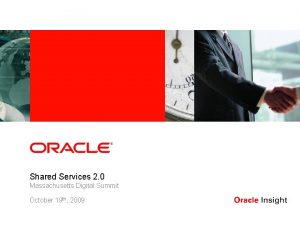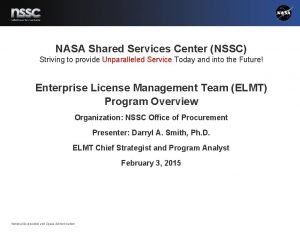What is shared services Shared Services is a




- Slides: 4

What is shared services? Shared Services is a way of organizing administrative functions to optimize the delivery of cost-effective, flexible, reliable services to all “customers”. Decentralized n Autonomous departments n Focus on responsiveness n Different systems and non-standard processes n Separate functional staff Standardized n Schools run similarly n Typically some common sub-systems n Common processes n Separate functional staff Centralized Shared Services Center n Single department or site which performs the function n Focus on efficiency and control n Typically some common sub-systems n No service level agreements nor performance targets n Separate organization but linked to n n Page 1 customers through oversight model Managed service delivery through clear service level agreements Customer driven transactions Performance driven culture through measurement and feedback Process ownership end-to-end

How is shared services different from centralization? Attribute Traditional View of Centralization Shared Services View Customers Treated as… End Users customers (e. g. , colleges, schools, units) Leadership Central Oversight Entity/ Headquarters Independent Unit—Customer Board/Advisory Group (organization varies with geographic objectives) Location Capitol Area/Headquarters High Skill, Low Cost Area Primary Focus Cost Control Service Excellence, High Performance, Cost Control, Continuous Improvement (service and costs) Service Responsibility Central Oversight Entity/ Headquarters Shared between shared services center and customers as stated in Service Level Agreements Service Management Optional Service Level Agreements, Key Performance Indicators, Performance Reporting Customer Contact Management Ad Hoc Multiple channels (e. g. , voice, email, web); Contact center staffed with customer service reps; Case Tracking software, Automated Call Distributor, Computer Telephone Integration; Client relationship managers Typical Management Processes Recruiting, Workload Management, Cost Management Customer Relationship Management, Continuous Improvement, Knowledge Management, Performance Management, Service Management Page 2

Shared services criteria Sample criteria used for Shared Services Poor Candidates for Shared Services Cost Benchmark Leading Practice Cost Type of Process StrategicConsultative Standardization No Potential to Standardize Transaction Volume Low Complexity of Task Highly Complex Stability Volatile Content Copyright © 2010 Accenture All Rights Reserved. Page 3 Strong Candidates for Shared Services High Cost Compared to Benchmark TransactionalAdministrative Standardization Exists or High Potential High (e. g. , more than 10 a day) Simple, Repeatable Static Content

What are the benefits for higher education? Economic § Higher productivity § Lower cost location § Reduced expenses § Reduced systems infrastructure costs § Leverage investments related to enterprise resource planning systems, other technology Page 4 Strategic Quality Speed § Shift funding/focus from back office to front office § Improved information for decision making § Reduced cycle times (for example): § Support meeting increased demand with fewer full time employees § Better service to key stakeholders (e. g. students, parents, faculty, and staff) § Achieve process and systems standardization § Reduced error rates quality at source § Enable new/re-organized entities § Develop centers of expertise and innovation § Close § Authorizations § Procurement § Payments § Billing § Sourcing







